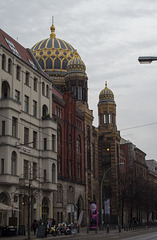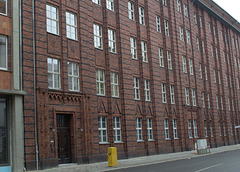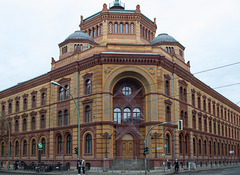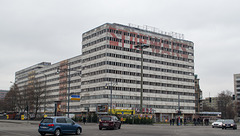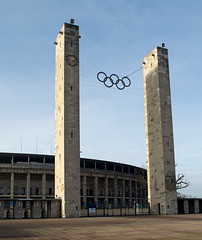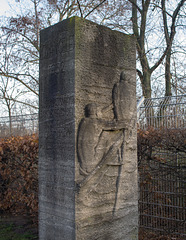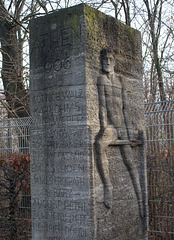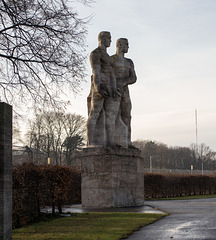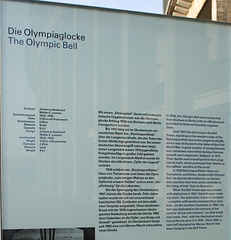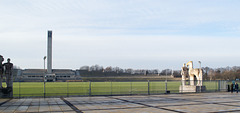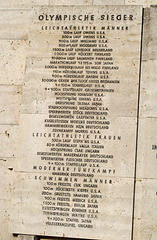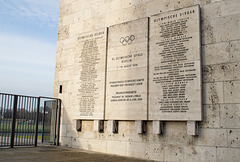
Europe2016
Berlin (#0142)
| |
|
New Synagogue, Berlin, built in 1859-1866 as the main synagogue for Berlin. It was badly damaged before and during WWII, much of what you see is a restoration.
Berlin (#0143)
| |
|
|
Near the New Synagogue, an interesting example of what I assume to be Brick Expressionism on Tucholskystraße. Per the link below the building was built in 1926 and is an expansion of the Telecommunications building on Oranienburger Straße (see flic.kr/p/x7uSW9) and the architect for this building was influenced by Chilehaus in Hamburg, which is considered to be a classic example of Brick Expressionism. See this building website (in German): www.deutsche-digitale-bibliothek.de/item/JCIH6FHEY5FHEOQAYZ3AW6BBC3ZZK72R
Berlin Postfuhramt (#0145)
| |
|
|
Postfuhramt, a former post office, built in 1881 per one site, the exterior is brick and terracotta. It looked interesting, but due to fencing for reconstruction, I couldn't get close enough to get a good look.
Berlin (#0150)
| |
|
From what I can determine, this building was an expansion of the Institute of Medicine building which is on the distant street. I seem to recall finding a reference to this as Bauhaus, but I can't locate that now. Here's a link about the building, in German: www.deutsche-digitale-bibliothek.de/item/5RTFWRXATTRUGCF5CSF7R7NWRXYVLQOS
Berlin Alexanderplatz (#0182)
| |
|
|
I could find no information on this massive abandoned building just on the edge of the very successful Alexanderplatz shopping area.
Berlin Olympic Stadium (#0440)
| |
|
Since I have a strong interest in how design is used to forward political agendas, it made logical sense for me to visit the site of the 1936 Olympic games. BUT, I knew that the stadium was still used as a sports venue and thus assumed that it had been mangled enough with remodeling that I would be disappointed in trying to get a sense of the 1936 stadium. I was very much wrong.
Not only is the stadium an excellent example of bending architecture to ideology, but the city does an outstanding job of describing that connection through placards around the stadium. In the following series of very many pictures, I’m including multiple pictures of the placards themselves since they say, much better than I would, the connection between design and National Socialist political moods/needs.
Berlin Olympic Stadium (#0439)
| |
|
The western entrance to the stadium, which is the entrance for those coming from the u-bahn station. Regarding the stadium itself, with the exception of the roof added relatively recently, the outside is little changed from how the stadium appeared in 1936. I could not find a specific name for these two towers
Berlin Olympic Stadium (#0441)
| |
|
A description of the stelae on the southern side of the stadium. The stelae represent the sports that the Germans won in various Olympics and the stelae on this side are described as fitting with Nazi art standards in that the athletes resemble marching columns rather than the more natural fluidity found in sports.
Berlin Olympic Stadium (#0444)
| |
|
Stelae with representations of the sports won by Germans in the 1932 Los Angeles Olympics.
Berlin Olympic Stadium (#0446)
| |
|
A stelae with representations of the sports won by Germans in the 1906 Athen Olympics.
Berlin Olympic Stadium (#0447)
| |
|
The Discus Throwers
As noted on the adjacent picture of the placard for this statue, the artists were encouraged to focus on physical beauty that ‘[promoted] the ideal of beauty epitomised by the “Nordic race.”’
Berlin Olympic Stadium (#0451)
| |
|
Description of the "Discus Throwers" statue and the demands of making them complimentary to the "Nordic race".
Berlin Olympic Stadium (#0457)
| |
|
On the sign next to the original bell, a surprisingly forthright description of the bell, the bell tower, later modifications, and Nazi symbolism.
Berlin Olympic Stadium (#0453)
| |
|
|
In the distance, just to the left of center, the bell tower. The bell in front of me is the original bell -- see adjacent picture.
Berlin Olympic Stadium (#0462)
| |
|
The German Stadium, built in 1912/13 and intended to be the site of the 1916 Olympic games. Due to WWI, those games were not held. When Germany was awarded the 1936 games, Hitled decided to build the Olympic Stadium, which is behind me.
Berlin Olympic Stadium (#0463)
Berlin Olympic Stadium (#0474)
| |
|
|
In the Marathon Gate, the symbolic entrance to the Olympic statium, a plaque of the winners of the 1936 Olympics. Jesse Owens name is near the top for 100 and 200m, and down several lines for 'weitsprung' (jump). He won other medals not listed on this plaque.
Berlin Olympic Stadium (#0476)
| |
|
|
The names of HItler and other Nazi leaders were removed from the plaques announcing the winner (and organizers) of the 1936 Olympics.
Jump to top
RSS feed- Latest items - Subscribe to the latest items added to this album
- ipernity © 2007-2024
- Help & Contact
|
Club news
|
About ipernity
|
History |
ipernity Club & Prices |
Guide of good conduct
Donate | Group guidelines | Privacy policy | Terms of use | Statutes | In memoria -
Facebook
Twitter

